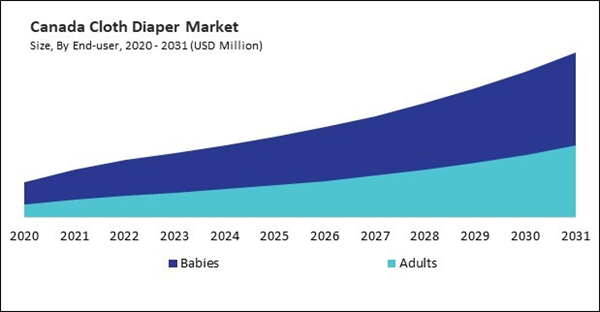Babies, typically infants and toddlers, benefit from cloth diapers' soft fabrics that are gentle on their delicate skin, reducing the risk of rashes and irritation. Parents and caregivers often choose cloth diapers for their reusable nature, contributing to waste reduction and sustainability efforts. Cloth diapers come in various designs, sizes, and materials to cater to different baby sizes and preferences, providing a reliable and eco-conscious alternative to disposable diapers for conscientious families. Hence, US region utilized9.04 million units of Cloth diaper for babies in the year 2023.
The US market dominated the North America Cloth Diaper Market, By Country in 2023, and would continue to be a dominant market till 2031; thereby, achieving a market value of$1.00 billion by 2031. The Canada market is experiencing a CAGR of 13.1% during (2024 - 2031). Additionally, The Mexico market would witness a CAGR of 12.1% during (2024 - 2031).
A cloth diaper is a reusable diaper made from natural fibers, synthetic materials, or a combination. It is designed to absorb and contain a baby’s urine and feces. Cloth diapers are a more environmentally friendly and sustainable solution than single-use disposable diapers, which generate a lot of waste. Cloth diapers may be washed and reused several times.
Cloth diapers are reusable alternatives to disposable diapers and find applications in various settings and scenarios. Parents commonly use cloth diapers to diaper infants at home. They offer a sustainable and cost-effective solution for managing diaper changes while minimizing environmental impact. Cloth diapers are available in different styles and sizes to accommodate the needs of newborns and infants. Many childcare centers and daycares incorporate cloth diapering into their programs as part of their commitment to sustainability and eco-conscious practices. Cloth diapers provide a reusable and hygienic option for daily diaper changes, reducing waste and promoting environmental responsibility.
A larger baby population naturally leads to a higher demand for diapers, including cloth diapers. As more babies are born, there is a greater need for diapering solutions, driving up the demand for cloth diapers in Canada. According to the 2021 Census of Population, over 1.8 million little ones were 0 to 4 years old in Canada, representing 4.95% of the population - nearly 1 in 20 Canadians. A large proportion of this age group needs diapers. The high baby population contributes to the overall growth of the cloth diaper market in Canada. Companies invest in research and development to create products that are more absorbent, comfortable, and user-friendly, catering to the preferences of Canadian consumers. Hence, the increasing e-commerce sector and rising demand for cloth diapers in the region drive the market's growth.
Based on End-user, the market is segmented into Babies and Adults. Based on Distribution Channel, the market is segmented into Offline and Online. Based on countries, the market is segmented into U.S., Mexico, Canada, and Rest of North America.
List of Key Companies Profiled
- The Procter and Gamble Company
- Nicki’s Diapers, LLC
- Johnson & Johnson
- Bumpadum Manufacturing and Traders Private Limited
- bumGenius (Cotton Babies, Inc.)
- GroVia
- Kanga Care LLC
- Gerber Childrenswear LLC
- SuperBottoms (Navashya Consumer Products Pvt Ltd)
- Bumkins Finer Baby Products, Inc
Market Report Segmentation
By End-user (Volume, Thousand Units, USD Billion, 2020-2031)- Babies
- Adults
- Offline
- Online
- US
- Canada
- Mexico
- Rest of North America
Table of Contents
Companies Mentioned
- The Procter and Gamble Company
- Nicki’s Diapers, LLC
- Johnson & Johnson
- Bumpadum Manufacturing and Traders Private Limited
- bumGenius (Cotton Babies, Inc.)
- GroVia
- Kanga Care LLC
- Gerber Childrenswear LLC
- SuperBottoms (Navashya Consumer Products Pvt Ltd)
- Bumkins Finer Baby Products, Inc
Methodology

LOADING...









